[wp_ad_camp_1]
Today, ferreting is termed a “field sport” and is when a group of people head off with their ferrets, dogs, birds of prey and guns (the latter three occasionally, not always) to rid the countryside of rabbits.
The hunters drape purse nets over the holes around the warren and then place their ferrets into the tunnels. The ferrets chase the rabbits out and they are caught in the nets where they are “dispatched by hand”.
Lurchers, a type of greyhound-looking dog, and terriers are also used to catch the rabbits as they bolt from their warren, as are hawks, which swoop down and grab the rabbit in their talons.
Hunters also use guns to kill the rabbits as they come racing out.
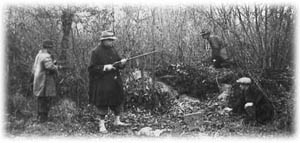
Certainly here in Western Australia farmers have contacted WAFFS and invited members up to their properties with their ferrets to get rid of rabbits.
And obviously during the tough times, when money and food was scarce, people used to take their ferrets out to hunt rabbits as a matter of necessity, so that they could feed their families.
Circa 9 BC
In his “Geographia”, Strabo describes the natives of the Gymnesian Islands (present day Balearic Islands) breeding Libyan ferrets which they muzzled and sent into holes to bolt the rabbits.
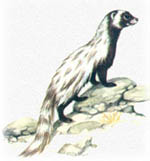
What were Libyan ferrets, I wonder. Were they like our present ferrets or the ancestors of the Ictonyx libyca, known either as the Saharan Striped Polecat or the Saharan Striped Weasel?
Look at this painting of the Ictonyx libyca … it almost looks like it’s wearing a cloak, doesn’t it? Somehow it doesn’t strike me as being a lean, mean, hunting machine!
What do you think?
The Middle Ages
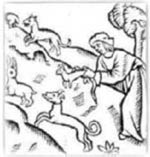
There appears to be quite a lot of ferreting activity during the Middle Ages. We have Genghis Khan hunting rabbits with his ferrets in the 12th century, then onwards through to the 15th century there were a number of tapestries and books which depict the sport of ferreting.
There’s a painting hanging in Avignon, done in 1343 by Matteo Giovanetti, showing a hunter letting his ferret go after a rabbit.
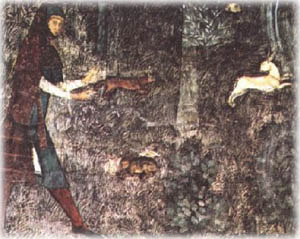
I can almost hear this cool Renaissance dude whispering, “Yo Lucrezia, il mio furetto caro. Va sic questo rascally coniglio!” (translated “Yo Lucrezia (sounded like a nifty name for a Renaissance ferret to me), my darling ferret. Go sic this rascally rabbit!”) 
Then there’s the “Livre de Chasse”.
Gaston III, the golden-haired count of Foix and Béarn, had the nickname “Phoebus” due to his bright blond locks.
He was an avid hunter and produced a book, “Livre de Chasse”, which was a definitive hunting manual for many centuries afterwards.
You can clearly see the purse nets draped over rabbit holes with the hunters holding ferrets in one of the illustrations. He also gave instructions as to how to make the purse nets in his “Book of the Hunt“.

Queen Mary’s Psalter has the medieval maidens a-ferreting …
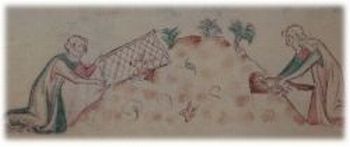
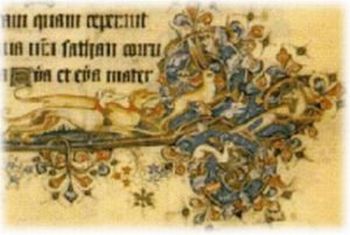
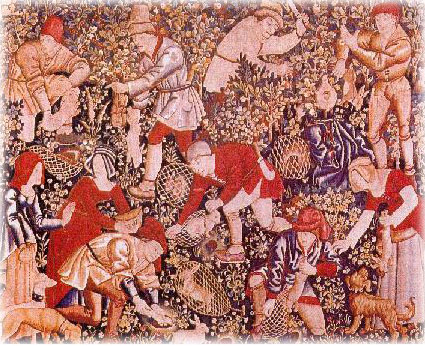
English Laws and Warreners
The first game law on the English statute book during the Middle Ages claimed that “no one who did not own lands worth 40 shillings a year was to keep a dog to hunt, or ferrets, nets, harepipes, cords, or other engines to destroy deer..”
In the 1660s in England, the household books of Lord William Howard, who lived in Naworth Castle in Cumberland, gives a detailed description about one of his servants, a warrener.
He had ferrets and was decked out with a carrying bag, yarn for mending his nets, traps, a ferret line and an implement for digging up his ferrets!
This chap had his own house and in 1622 a ferret room was added for all his ferrets, which shows that he was obviously a servant of note.
Dutch and French Ferreters
There is a painting by Paulus Potter (1625-1654), a Dutch painter and etcher who specialized in painting animals, showing a peasant with his dog watching his ferret approaching a rabbit hole.
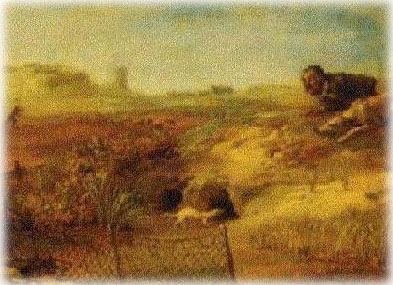
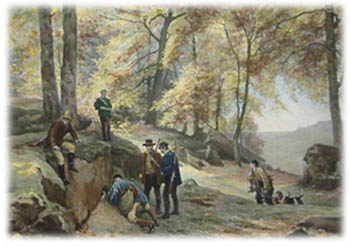
In Victorian Times
During Victorian times, ferrets used to cost 3s 6d, which was the same price as a little kitten. This would have come to a substantial amount of money in those days, so I’m surprised to read about poachers having ferrets. Makes you wonder how they could afford to get them!
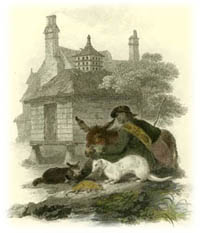
You’ll see that sable ferrets were referred to as “fitchew ferrets” in those days and they were considered to be more aggressive than the albinos.
CHAPTER XI
FERRETING: A RABBIT-HUNTERThe ferreting season commences when the frosts have caused the leaves to drop, and the rabbits grow fat from feeding on bark. Early one December morning, Orion and I started, with our man Little John, to ferret a double-mound for our old friend Farmer ‘Willum’ at Redcote.
Little John was a labourer — one of those frequently working at odd times for Luke, the Rabbit-Contractor. We had nicknamed him Little John because of his great size and unwieldy proportions. He was the most useful man we knew for such work; his heart was so thoroughly in it.
He was waiting for us before we had finished breakfast, with his tools and implements, having carefully prepared these while yet it was dark at home in his cottage. The nets require looking to before starting, as they are apt to get into a tangle, and there is nothing so annoying as to have to unravel strings with chilled fingers in a ditch. Some have to be mended, having been torn; some are cast aside altogether because weak and rotten. The twine having been frequently saturated with water has decayed. All the nets are of a light yellow colour from the clay and sand that has worked into the string.
These nets almost filled a sack, into which he also cast a pair of ‘owl-catchers,’ gloves of stout white leather, thick enough to turn a thorn while handling bushes, or to withstand the claws of an owl furiously resisting capture. His ferrets cost him much thought, which to take and which to leave behind. He had also to be particular how he fed them — they must be eager for prey, and yet they must not be starved,else they would gorge on the blood of the first rabbit, and become useless for hunting.
Two had to be muzzled — an operation of some difficulty that generally results in a scratched hand. A small piece of small but strong twine is passed through the jaws behind the tusk-like teeth, and tightly tied round, so tightly as almost to cut into the skin. This is the old way of muzzling a ferret, handed down from generations: Little John scorns the muzzles that can be bought at shops, and still more despises the tiny bells to hang round the neck. The first he says often come off, and thesecond embarrass the ferret and sometimes catch in projecting rootlets and hold it fast. He has, too, a line — many yards of stout twine wound about a short stick — to line a ferret if necessary.
The ferrets are placed in a smaller bag, tightly tied at the top — for they will work through and get out if any aperture be left. Inside the bag is a little hay for them to lay on. He prefers the fitchew ferret as he calls it; that is the sort that are coloured like a polecat. He says they are fiercer, larger of make and more powerful. But he has also a couple of white ones with pink eyes. Besides the sack of nets, the bagof ferrets, and a small bundle in a knotted handkerchief–his ‘nuncheon’ — which in themselves make a tolerable load, he has brought a billhook, and a ‘navigator,’ or draining-tool.
This is a narrow spade of specially stout make; the blade is hollow and resembles an exaggerated gouge, and the advantage is that in digging out a rabbit the tool is very apt to catch under a root, when an ordinary spade may bend and become useless. The ‘navigator’ will stand anything, and being narrow is also more handy. All these implements Little John has prepared by the dim light of a horn lantern in the shed at the back of his cottage. A mug of ale while we get our guns greatly cheers him, and unlooses his tongue.
All the way to Redcote he impresses on us the absolute necessity of silence while ferreting, and congratulates us on having a nearly still day. He is a little doubtful about Orion’s spaniel and whether it will keep quiet or not.
When we reach the double-mound, his talk entirely ceases: he is as silent and as rugged as a pollard oak. By the top of the mound the sack of nets is thrown down on the sward and opened. As there are more holes on the other side of the hedge Orion goes over with Little John, and I proceed to set up the nets on mine.
I found some difficulty in getting at the bank, the bushes being so thick, and had to use the billhook and chop a way in: I heard Little John growling about this in a whisper to Orion. Very often before going with the ferrets, people send a man or two a few hours previously to chop and clear the bushes. The effect is that the rabbits will not bolt freely. They hear the men chopping, and the vibration of the earth as they clumsily climb over the banks, and will not come out till absolutely forced. If it is done at all, it should be done a week beforehand. That was why Little John grumbled at my chopping though he knew it was necessary.
To set up a rabbit net you must arrange it so that it covers the whole of the mouth of the hole, for if there is any opening between it and the bank the rabbit will slip through. He will not face the net unless obliged to. Along the upper part, if the bank is steep, so that the net will not lie on it of itself, two or three little twigs should be thrust through the meshes into the earth to suspend it.
These twigs should be no larger than are used by birds in constructing their nests; just strong enough to hold the net in place and no more. On the other hand, care must be taken that no stout projecting root catches a corner of the net, else it will not draw up properly and the rabbit will escape.
Little John, not satisfied with my assurance that I had netted all the holes my side, now came over — crawling on hands and knees that he might not jar the bank — to examine for himself. His practised eye detected two holes that I had missed: one on the top of the mound much overhung by dead grass, and one under a stole. These he attended to. He then crawled up on the mound two or three yards below the end of the bury, and with his own hands stretched a larger net right across the top of the bank, so that if a rabbit did escape he would run into this. To be still moresure he stretched another similar net across the whole width of the mound at the other end of the bury.
He then undid the mouth of the ferret-bag, holding it between his knees — the ferrets immediately attempted to struggle out: he selected two and then tied it up again. With both these in his own hands, for he would trust nothing to another, he slipped quietly back to Orion’s side, and so soon as he saw I was standing well back placed them in different holes.
Almost the next instant one came out my side disarranging a net. I got into the ditch, hastily reset the net, and put the ferret to an adjacent hole, lifting up the corner of the net there for it to creep in. Unlike the weasel, a ferret once outside a hole seems at a loss, and wanders slowly about, till chance brings him to a second. The weasel used to hunting is no sooner out of one hole than he darts away to the next. But this power the ferret has partially lost from confinement.
For a moment the ferret hesitated inside the hole, as if undecided which of two passages to take: then he started, and I lost sight of his tail. Hardly had I got back to my stand than I heard Little John leap into the ditch his side: the next minute I saw the body of the rabbit which he had killed thrown out into the field.
I stood behind a somewhat advanced bush that came out into the meadow like a buttress, and kept an eye on the holes along the bank. It is essential to stand well back from the holes, and, if possible, out of sight. In a few moments something moved, and I saw the head of a rabbit at the mouth of a hole just behind the net. He looked through the meshes as through a lattice, and I could see his nostrils work, as he considered within himself how to pass this thing. It was but for a moment; the ferret came behind, and wild with hereditary fear, the rabbit leaped into the net.
The force of the spring not only drew the net together, but dragged out the peg, and rabbit and net inextricably entangled rolled down the bank to the bottom of the ditch. I jumped into the ditch and seized the net; when there came a hoarse whisper: ‘Look sharp you, measter: put up another net fust — he can’t get out; hould un under your arm, or in your teeth.’
I looked up, and saw Little John’s face peering over the mound. He had thrust himself up under the bushes; his hat was off; his weather-beaten face bleeding from a briar, but he could not feel the scratch so anxious was he that nothing should escape. I pulled another net from my pocket, and spread it roughly over the hole; then more slowly took the rabbit from the other net.
You should never hold a rabbit up till you have got fast hold of his hind legs; he will so twist and work himself as to get free from any other grasp. But when held by the hind legs and lifted from the ground he can do nothing. I now returned to my buttress of bushes and waited. The rabbits did not bolt my side again for a while. Every now and then I saw, or heard, Orion or Little John leap into their ditch, and well knew what it meant before the dead rabbit was cast out to fall with a helpless thud upon the sward.
Once I saw a rabbit’s head at the mouth of a hole, and momentarily expected him to dart forth driven by the same panic fear. But either the ferret passed, or there was another side-tunnel — the rabbit went back. Some few minutes afterwards Little John exclaimed: ‘Look out, you; ferret’s out!’ One of the ferrets had come out of a hole and was aimlessly — as it appeared — roaming along the bank.
As he came nearest my side, I got quietly into the ditch and seized him, and put him into a hole. To my surprise he refused to go in — I pushed him: he returned and continued to try to come out till I gave him a sharp fillip with the finger, when he shook the dust and particles of dry earth from his fur with a shiver, as if in protest, and slowly disappeared inside the hole.
As I was creeping out of the deep ditch on hands and knees, I heard Orion call angrily to the spaniel to come to heel. Hitherto the spaniel had sat on his haunches behind Orion fairly quiet and still, though not without an occasional restless movement. But now he broke suddenly from all control, and disregarding Orion’s anger — though with hanging tail — rushed into the hedge, and along the top of the mound where there was a thick mass of dead grass. Little John hurled a clod of clay at him, but before I was quite out of the ditch the spaniel gave tongue, and at the same moment I saw a rabbit come from the ditch and run like mad across the field.
The dog gave chase — I rushed for my gun, which was some yards off, placed against a hollow withy tree. The haste disconcerted the aim — the rabbit too was almost fifty yards away when I fired. But the shot broke one hind leg — it trailed behind — and the spaniel had him instantly. ‘Look at yer nets,’ said Little John in a tone of suppressed indignation, for he disliked the noise of a gun, as all other noises.
I did look, and found that one net had been partly pushed aside; yet to so small an extent that I should hardly have believed it possible for the rabbit to have crept through. He must have slipped out without the slightest sound and quietly got on the top of the mound without being seen. But there, alas! he found a wide net stretched right across the bank so that to slip down the mound on the top was impossible. This would certainly have been his course had not the net been there.
It was now doubtless that the spaniel caught wind of him, and the scent was so strong that it overcame his obedience. The moment the dog got on the bank, the rabbit slipped down into the rushes in the ditch — I did not see him because my back was turned in the act to scramble out. Then, directly the spaniel gave tongue the rabbit darted for the open, hoping to reach the buries in the hedge on the opposite side of the meadow.
This incident explained why the ferret seemed so loth to go back into the hole. He had crept out some few moments behind the rabbit and in his aimless uncertain manner was trying to follow the scent along the bank. He did not like being compelled to give up this scent and to search again for another. ‘Us must be main careful how us fixes our nets, you,’ said Little John, going as far as he could in reproof of my negligence.
The noise of the gun, the barking, and talking was of course heard by the rabbits still in the bury, and as if to show that Little John was right, for a while they ceased to bolt. Standing behind the bushes — against which I now placed the gun to be nearer at hand — I watched the nets till my eye was caught by the motions of the ferret-bag. It lay on the grass and had hitherto been inert. But now the bag reared itself up, and then rolled over, to again rise and again tumble. The ferrets left in it in reserve were eager to get out — sharp set on account of a scanty breakfast — and their motions caused the bag to roll along a short distance.
I could see Orion on the other side of the mound tolerably well because he was standing up and the leaves had fallen from the upper part of the bushes. Little John was crouched in the ditch: the dead grasses, ‘gicks,’ withered vines of bryony, the thistles, and dark shrivelled fern concealed him.
There was a round black sloe on the blackthorn beside me, the beautiful gloss, or bloom, on it made it look like a tiny plum. It tasted not only sour, but seemed to positively fill the mouth with a rough acid. Overhead light grey clouds, closely packed but not rainy, drifted very slowly before a N.E. upper current. Occasionally a brief puff of wind came through the bushes rustling the dead leaves that still remained on the oaks.
Despite the cold, something of Little John’s intense concentration communicated itself to us: we waited and watched with eager patience. After a while he got out of the ditch where he had been listening with his ear close against the bank, and asked me to pass him the ferret-bag. He took out another ferret and lined it — that is, attached one end of a long string to its neck, and then sent it in.
He watched which way the ferret turned, and then again placed his head upon the hard clay to listen. Orion had to come and hold the line, while he went two or three yards farther down, got into the ditch and once more listened carefully. ‘He be about the middle of the mound you,’ he said to me; he be between you and I. Lor! look out.’
There was a low rumbling sound — I expected to see a rabbit bolt into one of my nets, I heard Little John moving some leaves, and then he shouted, ‘Give I a net, you — quick. Lor! here be another hole: he’s coming!’ I looked over the mound and saw Little John, his teeth set and staring at a hole which had no net, his great hands open ready to pounce instantly like some wild animal on its prey. In an instant the rabbit bolted — he clutched it and clasped it tight to his chest. There was a moment of struggling, the next the rabbit was held up for a moment and then cast across his knee.
It was always a sight to see Little John’s keen delight in ‘wristing’ their necks. He affected utter unconsciousness of what he was doing, looked you in the face, and spoke about some indifferent subject. But all the while he was feeling the rabbit’s muscles stretch before the terrible grasp of his hands, and an expression of complacent satisfaction flitted over his features as the neck gave with a suddenlooseness, and in a moment what had been a living straining creature became limp.
The ferret came out after the rabbit; he immediately caught it and thrust it into his pocket. There were still two ferrets in — one that was suspected to be gorging on a rabbit in a cul de sac, and the other lined, and which had gone to join that sanguinary feast. The use of the line was to trace where the loose ferret lay. ‘Chuck I the show’l, measter,’ said Little John.
I gave the ‘navigator’ tool a heave over the hedge; it fell and stuck upright in the sward. Orion handed it to him. He first filled up the hole from which a rabbit had just bolted with a couple of ‘spits,’ i.e. spadefuls, and then began to dig on the top of the mound.
This digging was very tedious. The roots of the thorn bushes and trees constantly impeded it, and had to be cut. Then upon at last getting down to the hole, it was found that the right place had not been hit by several feet. Here was the line and the lined ferret — he had got hitched in a projecting root, and was furiously struggling to go forward to the feast of blood.
Another spell of digging — this time still slower because Little John was afraid lest the edge of his tool should suddenly slip through and cut his ferret on the head, and perhaps kill it. At last the place was reached and the ferret drawn forth still clinging to its victim. The rabbit was almost beyond recognition as a rabbit. The poor creature had been stopped by a cul de sac, and the ferret came upon him from behind.
As the hole was small the rabbit’s body completely filled it, and the ferret could not scramble past to get at the spot behind the ear where it usually seizes. The ferret had therefore deliberately gnawn away the hindquarters and so bored a passage. The ferret being so gorged was useless for further hunting and was replaced in the bag. But Little John gave him a drink of water first from the bottom of the ditch.
Orion and I, wearied with the digging, now insisted on removing to the next bury, for we felt sure that the remaining rabbits in this one would not bolt. Little John had no choice but to comply, but he did so with much reluctance and many rueful glances back at the holes from which he took the nets. He was sure, he said, that there were at least half-a-dozen still in the bury: he only wished he might have all that he could get out of it. But we imperiously ordered a removal.
We went some thirty yards down the mound, passing many smaller buries, and chose a spot perfectly drilled with holes. While Little John was in the ditch putting up nets, we slily undid the ferret-bag and turned three ferrets at once loose into the holes. ‘Lor! measter, measter, what be you at?’ cried Little John, quite beside himself. ‘You’ll spoil all on it. Lor!’
A sharp report as Orion fired at a rabbit that bolted almost under Little John’s fingers drowned his remonstrances, and he had to scramble out of the way quick. Bang! bang! right and left: the firing became rapid. There being no nets to alarm the rabbits and three ferrets hunting them, they tumbled out in all directions as fast as we could load. Now the cartridges struck branches and shattered them. Now theshot flattened itself against sarsen stones imbedded in the mound. The rabbits had scarce a yard to bolt from one hole to another, so that it was sharp work.
Little John now gave up all hope, and only pleaded piteously for his ferrets. ‘Mind as you doan’t hit ’em, measter; doant’ee shoot into a hole, you.’ For half an hour we had some really good shooting: then it began to slacken, and we told him to catch his ferrets and go on to the next bury. I am not sure that he would not have rebelled outright but just then a boy came up carrying a basket of provisions, and a large earthenware jar with a bung cork, full of humming ale. Farmer Willum had sent this, and the strong liquor quite restored Little John’s good humour. It really was ale — such as is not to be got for money.
The boy said that he had seen Farmer Willum’s hereditary enemy, the keeper, watching us from his side of the boundary, doubtless attracted by the sound of the firing. He said also that there was a pheasant in a little copse beside the brook. We sent him out again to reconnoitre: he returned and repeated that the keeper had gone, and that he thought he saw him enter the distant fir plantations. So we left the boy to help Little John at the next bury — a commission that made him grin with delight, and suited the other very well, since the noisy guns were going away, and he could use his nets.
We took the lined ferret with us, and started after the pheasant. Just as we approached the copse, the spaniel gave tongue on the other side of the hedge. Orion had tied him up to a bush, wishing to leave him with Little John. But the spaniel tore and twisted till he got loose and had followed us — keeping out of sight — till now crossing the scent of a rabbit he set up his bark. We called him to heel, and I am afraid he got a kick. But the pheasant was alarmed, and rose before we could properly enfilade the little copse, where we should most certainly have had him. He flew high and straight for the fir plantations, where it was useless to follow.
However, we leaped the brook and entered the keeper’s territory under shelter of a thick double-mound. We slipped the lined ferret into a small bury, and succeeded in knocking over a couple of rabbits. The object of using the lined ferret was because we could easily recover it. This was pure mischief, for there were scores of rabbits on our own side. But then there was just a little spice of risk in this, and we knew Willum would gloat over it.
After firing these two shots we got back again as speedily as possible, and once more assisted Little John. We could not, however, quite resist the pleasure of shooting a rabbit occasionally and so tormenting him. We left one hole each side without a net, and insisted on the removal of the net that stretched across the top of the bank. This gave us a shot now and then, and the removal of the cross net allowed the rabbit some little law.
Notwithstanding these drawbacks — to him — Little John succeeded in making a good bag. He stayed till it was quite dark to dig out a ferret that had killed a rabbit in the hole. He took his money for his day’s work with indifference: but when we presented him with two couple of clean rabbits his gratitude was too much for him to express. The gnawn and ‘blown’ rabbits [by shot] were his perquisite, the clean rabbits an unexpected gift. It was not their monetary value; it was the fact that they were rabbits.
The man’s instinct for hunting was so strong that it seemed to overcome everything else. He would walk miles — after a long day’s farm work — just to help old Luke, the rabbit contractor, bring home the rabbits in the evening from the Upper Woods. He worked regularly for one farmer, and did his work well: he was a sober man too as men go, that is he did not get drunk more than once a month. A strong man must drink now and then: but he was not a sot, and took nine-tenths of his money faithfully home to his wife and children.
In the winter when farm work is not so pressing he was allowed a week off now and then, which he spent in ferreting for the farmers, and sometimes for Luke, and of course he was only too glad to get such an engagement as we gave him. Sometimes he made a good thing of his ferreting: sometimes when the weather was bad it was a failure. But although a few shillings were of consequence to him, it really did not seem to be the money-value but the sport that he loved. To him that sport was all-absorbing.
His ferrets were well looked after, and he sometimes sold one for a good price to keepers. As a rule a man who keeps ferrets is suspected: but Little John was too well understood, and he had no difficulty in begging a little milk for them.
His tenacity in pursuit of a rabbit was always a source of wonder to me. In rain, in wind, in frost; his feet up to the ankle in the ice-cold slush at the bottom of a ditch: no matter what the weather or how rough, he patiently stood to his nets. I have known him stand the whole day long in a snowstorm–the snow on the ground and in the holes, the flakes drifting against his face — and never once show impatience. All he disliked was wind — not on account of discomfort, but because the creaking of the branches and the howling of the blast made such a noise that it was impossible to tell where the rabbit would bolt.
He congratulated himself that evening because he had recovered all his ferrets. Sometimes one will lie in and defy all efforts to bring it out. One plan is to place a dead fresh rabbit at the mouth of the hole which may tempt the ferret to come and seize it. In large woods there are generally one or more ferrets wandering loose in the season, that have escaped from the keepers or poachers.
If the keeper sees one he tries to catch it; failing that, he puts a charge of shot into it. Some keepers think nothing of shooting their own ferrets if they will not come when called by the chirrup with the lips, or displease them in other ways. They do not care, because they can have as many as they like. Little John made pets of his: they obeyed him very well as a rule.
Poaching men are sometimes charged with stealing ferrets, i.e. with picking up and carrying off those that keepers have lost. A ferret is, however, a difficult thing to identify and swear to.
Those who go poaching with ferrets choose a moonlight night: if it is dark it is difficult to find the holes. Small buries are best because so much more easily managed, and the ferret is usually lined. If a large bury is attempted, they take the first half-dozen that bolt and then move on to another. The first rabbits come out rapidly; the rest linger as if warned by the fate of their companions. Instead of wasting time over them it is best to move to another place.
Unless a keeper should chance to pass up the hedgerow there is comparatively little risk, for the men are in the ditch and invisible ten yards away under the bushes and make no noise. It is more difficult to get home with the game: but it is managed. Very small buries with not more than four or five holes may be ferreted even on the darkest nights by carefully observing beforehand where the holes are situate.
Click HERE to read all of “The Amateur Poacher”.
Up to the Present Day …
Although ferrets were introduced to America, ferreting didn’t seem to take off like it did in Australia and other places. In fact, it appears that it’s actually illegal to go hunting with ferrets in the States.
Many people used to ferret during the Great Depression in Australia and even 10 years after the end of World War II, you can see a photo of two German ferreters wandering through the ruins of Berlin with their ferrets, Fritz (on the shoulder) and Lotte (facing the camera).
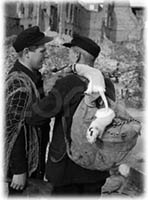
You can read about how they go ferreting with a very special dog called the Kelb tal-Fenek with a “nemes” (ferret) to chase the “fenek” (rabbit) in Malta. This pooch originated there and was erroneously called a Pharaoh Hound in the past. (See the links at the end of this page  ).
).
We were in Malta briefly in 1984 – how I wish I had this information so that I could have witnessed the Kalb tal-Fenek and nemes at work firsthand!
There are a number of resources on the WWW for people who want to learn more about ferreting.
The Ferreter shows people how to work ferrets, how to keep them in decent accommodation outside and how to show them in the UK amongst other things.
For those of you who might be visiting England, or even who live there, and who want to have a taste of ferreting, I’ve found a couple of sites which offer the experience!
You can go up to Cheshire and have a day, or more, hunting rabbits with not only ferrets, but hawks as well, as described on the Cheshire Falconry website.
If you wanted to splash out, you could probably order a fancy hamper stuffed with haggis, smoked Scottish salmon, oatmeal biscuits, and other Highland goodies, and wash your food down with a dram (or three) of Glenfiddich!
Mind you, if you did that you’d probably end up falling into a rabbit hole and breaking your ankle, which probably wouldn’t be a good way to wrap up your ferreting experience. 
Ferreting and Falconry
I happened upon this rather interesting “book” called “The Art of Medieval Faulconry” and thought it was worth making available for those of you who’d like to read about falconry.
You can download the pdf file HERE.
A Personal Take on Ferreting
Back in 1995 we went ferreting with WAFFS (West Australian Ferret & Ferreting Society). Some farmer invited members to bring their ferrets along to his property out “wup wup” (Aussie for ‘out in the sticks’) to get rid of those wascally wabbits.
We took the kids, two of our ferrets, a tent and drove for about 2 hours to the farm, where we met up with other members and set up our tent. The evening was very sociable – a BBQ, lots of red wine to protect us from the chilly autumnal winds and a big bonfire to gather around afterwards.

The next day we were up with the birds and watched a couple of hot air balloons floating over us in the valley shrouded by the misty dawn. It was all so serene and beautiful but very, very cold.

It was about 10 when everyone thawed out enough to go ferreting.
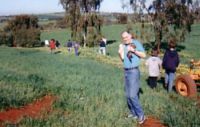
Philip went with the kids and took Scully. I stayed behind to look after Chucky, as I really wasn’t keen to go chasing after rabbits.
11 o’clock came and went.
12 o’clock came and went.
1 o’clock came and went and by this time I could see a few of the people making their way back, but not Philip and the kids. I asked if anyone knew where they were and one fellow said that he’d seen them standing around a rabbit hole a while ago.
I was beginning to get very worried by 2 pm but as I didn’t know where they were, it seemed idiotic for me to head out to look for them. More people were drifting back to camp but when asked, no one seemed to know where they were.
By 3 pm I was ready to call the Police, the Fire Brigade, even the ruddy SAS and my imagination was running riot, conjuring up all sorts of dreadful things that could have happened to them when I finally caught sight of four familiar figures slowly heading my way. No one seemed to be limping or wrapped in bandages, so they couldn’t have fallen down a mine shaft or whatever else my overworked, anxious mind had feverishly dreamt up. I hurried to meet them and found 3 very grumpy and tired children and a stressed out husband clutching Scully.
It transpired that there were no rabbits on the property (they must have got word that the ferrets were coming so had hopped off to their rellies’ burrows in adjacent farms) so Philip thought it’d be fun to give Scully the experience of going down a burrow.
He put her down a hole and they all stood there, waiting for her to come straight back up. The trouble was, she didn’t! I guess all the smells, etc, had been so interesting that she stayed down there for all that time – and during that time, the kids and Philip were up top, getting more and more fretful about where she was and what they were going to say to me if she didn’t come back up.
Fortunately that didn’t happen.
Scully finally clambered out of the same hole she went down looking like she’d just woken up from a deep sleep and Philip had scooped her up with total relief and told her in no uncertain terms that she wouldn’t be going down rabbit holes ever again! 
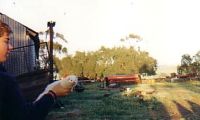
If you want to learn more about ferreting, check out these sites …


Wait, you people seriously took an untrained ferret out hunting? WTF is wrong with you?
for real i mean what if the ferret got ate whatbwould you do that you people are stuped